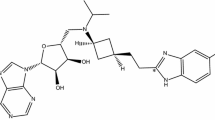Abstract
The pharmacokinetic disposition of anagliptin, an orally active and highly selective dipeptidyl peptidase-4 (DPP-4) inhibitor was evaluated in male rats and dogs. Anagliptin was well absorbed in dogs (70.4 %) and moderately to well absorbed in rats ranging from 38.1 to 85.5 % depending on the dose. In situ testing indicated that anagliptin absorption from rat intestine was apparently limited by P-glycoprotein. The absorbed radioactivity was distributed rapidly throughout the body, and high levels of radioactivity were found in the tissues expressing DPP-4 at high levels, especially small intestine, kidney and liver. In both species, the major circulating component was unchanged anagliptin; major circulating metabolites were M1 resulting from hydrolysis of the cyano group and M6 and M7, both of which resulting from the oxidation-cleavage of the methylene function adjacent to the amine. After intravenous dosing, urinary excretion of radioactivity was the major route of elimination for rats (64.6 %) and dogs (66.2 %), and biliary excretion was demonstrated to be an important pathway in rats (25.2 %). The total recovery was good (97.5–99.5 %) and most of the radioactivity was excreted by 24 h in both species. The renal clearance of unbound anagliptin in rats (91.7 ml/min/kg) was much higher than the glomerular filtration rate, indicative of active renal elimination.


Similar content being viewed by others
References
Ahren B (2009) Clinical results of treating type 2 diabetic patients with sitagliptin, vildagliptin or saxagliptin—diabetes control and potential adverse events. Best Pract Res Clin Endocrinol Metab 23:487–498
Arimori K, Kuroki N, Hidaka M, Iwakiri T, Yamsaki K, Okumura M, Ono H, Takamura N, Kikuchi M, Nakano M (2003) Effect of P-glycoprotein modulator, cyclosporin A, on the gastrointestinal excretion of irinotecan and its metabolite SN-38 in rats. Pharm Res 20(6):910–917
Caron N, Kramp R (1999) Measurement of changes in glomerular filtration rate induced by atrial natriuretic peptide in the rat kidney. Exp Physiol 84:689–696
Duez H, Cariou B, Staels B (2012) DPP-4 inhibitors in the treatment of type 2 diabetes. Biochem Pharmacol 83(7):823–832
Furuta S, Smart C, Hackett A, Benning R, Warrington S (2012) Pharmacokinetics and metabolism of [14C]anagliptin, a novel dipeptidyl peptidase-4 inhibitor, in humans. Xenobiotica. Oct 18: [Epub ahead of print]
Halimi S, Schweizer A, Minic B, Foley J, Dejager S (2008) Combination treatment in the management of type 2 diabetes: focus on vildagliptin and metformin as a single tablet. Vasc Health Risk Manag 4(3):481–492
Holst JJ, Deacon CF (2005) Glucagon-like peptide-1 mediates the therapeutic actions of DPP-IV inhibitors. Diabetologia 48:612–615
Idris S, Donnelly R (2007) Dipeptidyl peptidase-IV inhibitors: a major new class of oral antidiabetic drug. Diabetes Obes Metab 9:153–165
Kato N, Oka M, Murase T, Yoshida M, Sakairi M, Yamashita S, Yasuda Y, Yoshikawa A, Hayashi Y, Makino M, Takeda M, Mirensha Y, Kakigami T (2011) Discovery and pharmacological characterization of N-[2-({2-[(2S)-2-cyanopyrrolidin-1-yl]-2-oxoethyl}amino)-2-methylpropyl]-2-methylpyrazolo[1,5-a]pyrimidine-6-carboxamide hydrochloride (anagliptin hydrochloride salt) as a potent and selective DPP-IV inhibitor. Bioorg Med Chem 19(23):7221–7227
Komatsu R, Matsuyama T, Namba M, Watanabe N, Itoh H, Kono N, Tarui S (1989) Glucagonostatic and insulinotropic action of glucagon-like peptide I-(7–36)-amide. Diabetes 38:902–905
Lambeir AM, Durinx C, Scharpé S, De Meester I (2003) Dipeptidyl-peptidase IV from bench to bedside: an update on structural properties, functions, and clinical aspects of the enzyme DPP IV. Crit Rev Clin Lab Sci 40(3):209–294
Mentlein R (1999) Dipeptidyl-peptidase IV (CD26)—role in the inactivation of regulatory peptides. Regul Pept 85:9–24
Mest HJ, Mentlein R (2005) Dipeptidyl peptidase inhibitors as new drugs for the treatment of type 2 diabetes. Diabetologia 48:616–620
Nauck MA, Bartels E, Orskov C, Ebert R, Creutzfeldt W (1993) Additive insulinotropic effects of exogenous synthetic human gastric inhibitory polypeptide and glucagon-like peptide-1-(7–36) amide infused at near-physiological insulinotropic hormone and glucose concentrations. J Clin Endocrinol Metab 76:912–917
Orskov C, Holst JJ, Nielsen OV (1988) Effect of truncated glucagon-like peptide-1 [proglucagon-(78–107) amide] on endocrine secretion from pig pancreas, antrum, and nonantral stomach. Endocrinology 123:2009–2013
Sharma MD (2010) Role of saxagliptin as monotherapy or adjunct therapy in the treatment of type 2 diabetes. Ther Clin Risk Manag 25(6):233–237
Stumvoll M, Goldstein BJ, van Haeften TW (2005) Type 2 diabetes: principles of pathogenesis and therapy. Lancet 365(9467):1333–1346
Sunami Y, Yoshioka N, Hayashi I, Ishida T (2007) Safety, tolerability, pharmacokinetics and pharmacodynamics of SK-0403, a Novel DPP-IV inhibitor, in healthy Japanese subjects. American Diabetes Association 67th Scientific Session, Chicago, IL, June 22–26, Poster 0482-P [Online] Available at: http://professional.diabetes.org/Content/Posters/2007/p0482-P.pdf. Accessed on 11 Sept 2012
Thornberry NA, Gallwitz B (2009) Mechanism of action of inhibitors of dipeptidyl-peptidase-4 (DPP-4). Best Pract Res Clin Endocrinol Metab 23(4):479–486
Wang E, Meier DJ, Sandoval RM, Von Hendy-Willson VE, Pressler BM, Bunch RM, Alloosh M, Sturek MS, Schwartz GJ, Molitoris BA (2011) A portable fiberoptic ratiometric fluorescence analyzer provides rapid point-of-care determination of glomerular filtration rate in large animals. Kidney Int 31:1–6
Zerilli T, Pyon EY (2007) Sitagliptin phosphate: a DPP-4 inhibitor for the treatment of type 2 diabetes mellitus. Clin Ther 29:2614–2634
Acknowledgments
A part of this work was performed in cooperation with Kowa Co. Ltd and Sekisui Medical Co. Ltd. The authors thank all the members of those companies for valuable suggestions regarding the analysis of the data.
Conflict of interest
None.
Author information
Authors and Affiliations
Corresponding author
Rights and permissions
About this article
Cite this article
Furuta, S., Tamura, M., Hirooka, H. et al. Pharmacokinetic disposition of anagliptin, a novel dipeptidyl peptidase-4 inhibitor, in rats and dogs. Eur J Drug Metab Pharmacokinet 38, 87–96 (2013). https://doi.org/10.1007/s13318-013-0119-z
Received:
Accepted:
Published:
Issue Date:
DOI: https://doi.org/10.1007/s13318-013-0119-z




